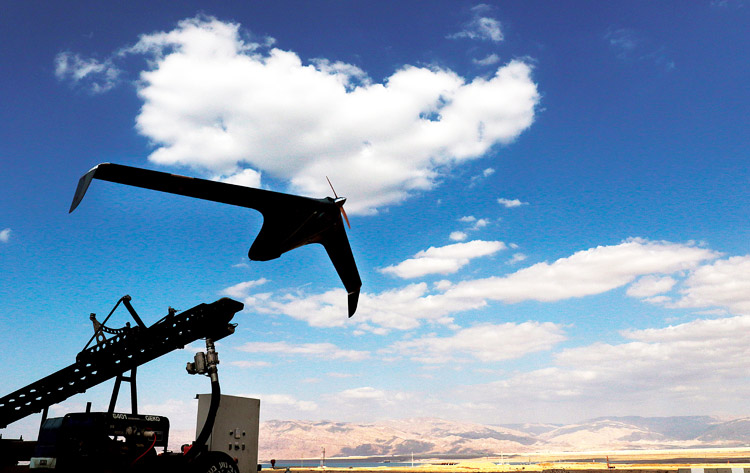- Prime Minister Narendra Modi inaugurates Aero India 2023 in Bengaluru; Releases Commemorative Stamp
- Defence Secretary meets delegations from Saudi Arabia, USA and Oman on the sidelines of Aero India 2023
- Foreign Ministers of 32 countries to attend Aero India 2023
- Embraer showcases the C-390 Millennium at Aero India 2023
Tactical Intelligence Solutions for Land Forces

Modern land forces face challenges managing large formations in complex terrain. In both static and maneuver warfare, operations are fluid and dynamic. Planned at the command, army or division level, they are designed to achieve operational goals, but the translation of such plans to the tactical level must adapt to the new realities of asymmetric warfare.
Asymmetry is not limited to guerilla and low intensity conflicts, but it is implemented in the use of superior technology such as stealth, mobility, and effects, including precision strike and cyber. The area of responsibility (AOR) ofthe brigade and battalion have increased and are now exceeding areaspreviously controlled by divisions. Quite often battalions are assigned an AORspanning 20km of front line, and 40 km deep into enemy area, while maintaining an ‘area of interest’ (AOI) ranging up to 100 km deep.
Relying on organic assets
To dominate such large areas tactical formations from brigade and below are prepared to conduct their missions relying on organic assets — infantry, armor, artillery, and combat support elements necessary for their operations. While sophisticated and advanced, these assets are designed to fight within visual range. When engaging distant targets, those formations depend on intelligence and targeting provided by the higher echelons even when their firepower (artillery, helicopters or guided weapons) is in range. Such intelligence is collected by satellites, drones, radars and other forms of electronic surveillance that monitor those areas in real time, and centrally processed, analysed and transferred to the users in form of intelligence reports and target lists.
When those distant targets are stationary, and operations unfold along preplanned processes, this hierarchy works fine. But what happens when the forces are moving? Enemy artillery entering firing positions? Their resupply convoy move in to replenish an exhausted battalion? Anti-tank ambush set to close a mountain path you plan to use? These are important intel bits that includes actionable targets, that would rarely trickle down to the battalion in relevant real time to be actionable.
These insights were part of lessons learned during Israel’s ‘Second Lebanon War’ of 2006. Through the month-long campaign, combat units engaged in combat in the mountainous terrain of Southern Lebanon were limited by their ability to obtain intelligence and situational picture in near-real-time, although such intel was available at higher echelons.
Due to the centralised nature of military intelligence, the tactical echelons — those combat formations that are facing the enemy head on — often get trickles of the huge volumes of information generated at the operational level, reflecting battlespace pictures that are often outdated and irrelevant to the situation in hand.
Tactical Intelligence by IAI
To fill this gap Israel’s leading defense enterprise, Israel Aerospace industries (IAI) developed the new Tactical Intelligence concept based on operationally proven building blocks, integrated and adapted to operate with the maneuver forces. “Tactical Intelligence capabilities enable commanders at the battalion and brigade to look through the smoke, beyond the hill and over the next ridge, to dominate the entire AOR and well into the AOI” Avi Bleser, Vice Presdient Marketing & Sales at IAI’s MALAT division explains. “It focuses the commander’s attention on the objectives and targets that are the most relevant to them, relying on organic assets.”
According to Bleser, IAI’s BirdEye 650D mini-drones is a central element of IAI’s Tactical Intelligence solution and offers mission endurance of 20 hours. These drones typically operate at altitudes up to 15,000 ft and over distances of 150 km.It carries electro-optical payloads that provide excellent imagery for situational understanding and targeting. Each drone can carry additional payloads, including electronic sensors and communications relays to maintain communications continuity over complex terrain. An electrically-powered variant can be used for specialised, shorter missions, where low acoustic signature is mandatory. The drones are operated from standard tactical vehicles equipped to carry, launch, control, retrieve and support multiple drones.
Hovermast, hybrid vehicle
The battalion operates a different solution — the Hovermast. “This hybrid vehicle is an electrically-powered quadrotor tethered to the command vehicle by a cable that provides electrical power and downloads imagery and data” Bleser noted. “As an automatically operated sensor Hovermast can be integrated into any combat vehicle — tank, command APC or light utility vehicle, providing an elevated view of the terrain and targets within its line sight”he added. While each Hovermast is controlled and monitored by the user, it is also linked via wideband datalink to the brigade, providing instant situational report.
What makes these elements a ‘Tactical Intelligence Solution’ is the Real-Time Image Intelligence Center (RICent) element that collects, processes and analyses the information. RICent was originally developed by IAI Elta to manage real-time intelligence repository at the strategic level. “A derivative of the system is now available for tactical use. A brigade would operate several RICnet nodes to maintain operational continuity. Using wide-band communications these nodes are interlinked with drones and Hovermasts, as well as other collecting assets the brigade may have, to create a unified intelligence picture” Bleser added.
“The Tactical Intelligence Solution IAI offers is unique in the integration advanced technology solutions” Bleser concludes, “Adding the operational and logistical maturity makes this battle winning solution a perfect element in the brigade modernisation.”





